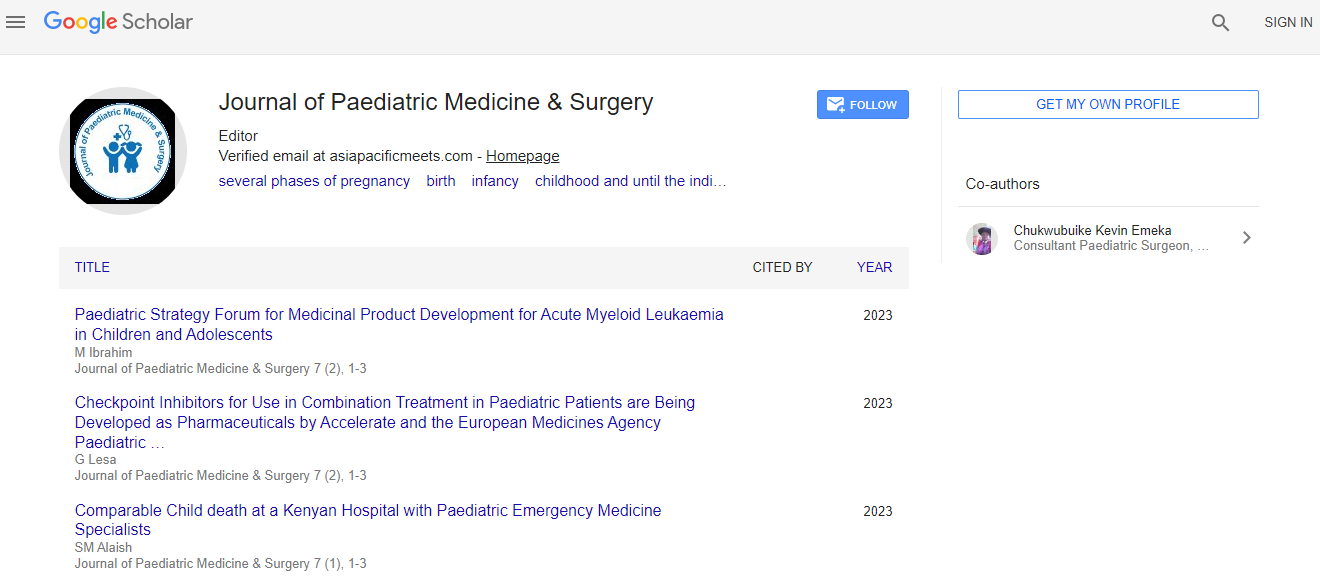Health Care, Nutrition & Pediatrics Meet 2019: Management of hypertension in children and adolescents - Mazen Abou Chaaban - Emirates Specialty Hospital
*Corresponding Author:
Copyright: © 2019 . This is an open-access article distributed under the terms of the Creative Commons Attribution License, which permits unrestricted use, distribution, and reproduction in any medium, provided the original author and source are credited.
Abstract
Blood pressure in pediatric age group varies with age, sex and height. It is categorized into primary and secondary hypertension (an underlying cause can be identified). Essential hypertension is being increasingly recognized in children especially in adolescents and form 12% to 18% of the Etiology of hypertension in this age group. In recent days treatment of hypertension in youngsters and adolescents has been distinctly changed. These pediatric hypertension guidelines are an update to the 2004 “Fourth Report on the Diagnosis, Evaluation, and Treatment of High Blood Pressure in Children and Adolescents”. One of the most modern classification schemes for blood pressure in adolescents and children is that recommended by the United States National High Blood Pressure Education Program (NHBPEP) Working Group in 2004. However this system has its flaws (for example, reliance on one blood pressure measurement per subject, obtained with a mercury sphygmomanometer), but it has been generally adopted worldwide. Treatment for essential hypertension is mainly non-pharmacological in the form of weight reduction, including the publication of new consensus recommendations, the obesity epidemic, and the increased availability of information on efficacy and safety of antihypertensive medications in the young. In this review we current and modernized method to the outpatient organization of hypertension in the adolescent or child, developing representative cases to illustrate main principles as well as possible controversies, reduction of salt intake and exercise. Mild pharmacological treatment is needed in some patients as supplementary to the other. Hypertension in children and adolescents is mainly secondary in origin. In grown-ups, the definition of hypertension is based upon results such as stroke and myocardial infarction; large-scale people studies have established that the incidence of these events rises in a lined fashion, opening with blood pressures.
Such type of outcomes are extremely very rare in children and adolescents, the definition of elevated blood pressure in the young is a statistical one, derived from databases of blood pressures obtained in healthy children. Renal parenchymal disease is the most frequent (70-80%) causes of secondary hypertension while renovascular, cardiovascular and endocrinal disorders constitute only 20-30%. In secondary hypertension, treatment of the underlying etiology is in most of the cases, the key of success in the management of hypertension. Although the approach to the treatment of hypertensive children differs somewhat from that of the adult and the general principals are similar. Pharmacological treatment is mandatory in these patients and should be done under the following rules; should be used in stepwise fashion, the least toxic drug should be prescribed first, use maximum recommended dose of one pharmacological drug prior to adding another and when combined drug therapy is used, the drug being prescribed should have different sites or modes of action in order to attain an additional effect. Some of the antihypertensive drugs used are diuretics which are used as first line of treatment as well as in combination with other medications (e.g. Thiazine, Furosemide, etc.).
Beta blockers can be used safely alone or in combination with others if there is no contraindication to their use as in bronchial asthma and congestive heart failure (e.g. Propranolol, Atenolol, Metoprolol, Pindol, etc.) Their mode of action is mainly by reduction in the heart rate and cardiac output and blockage of the release of renin from the kidneys in response to adrenergic stimulation. Alpha and beta-blocking agents (e.g. Labetalol) have added useful and safe lines in the treatment of chronic as well as acute hypertensive emergencies in pediatrics. Calcium channel blocking agents act on the smooth muscle cells of the blood vessels and inhibit the influx of calcium causing inhibition of the tone of the smooth muscles leading to peripheral vasodilatation and thus reducing the peripheral resistance (e.g. Verapamil, Nefidipine, Amlodipine and others.). Angiotensin converting enzyme inhibitors block the biotransformation of angiotensin I to angiotensin II and subsequently prevent the vasoconstriction and the release of renin and aldosterone. They are of great benefit in the treatment of high-renin hypertension. Other categories of antihypertensive drugs which are used in emergencies and in non-responder children and adolescents are alpha-adrenergic blocking agents, peripheral vasodilators and centrally acting alpha stimulators. Close monitoring, follow ups, parents and patients understanding and compliance are essential to assure proper and successful management of hypertension in children and adolescents.

 Spanish
Spanish  Chinese
Chinese  Russian
Russian  German
German  French
French  Japanese
Japanese  Portuguese
Portuguese  Hindi
Hindi 